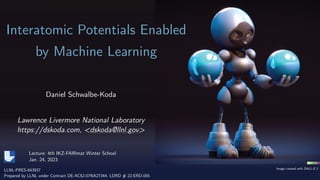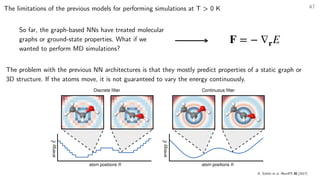The document presents an overview of using machine learning, particularly neural networks, for fitting interatomic potentials in atomistic simulations. It discusses the advantages and challenges of traditional force fields versus machine learning approaches, highlighting the trade-offs between computational cost and accuracy. It also explores the role of deep learning and graph-based representations in advancing the modeling of materials and chemical systems.




![5
Sometimes, the properties of interest can be obtained from simpler models
V(r) = 4ε
[(
σ
r )
12
−
(
σ
r )
6
]
Instead of using quantum mechanics or DFT
to model a PES, we can use simpler models
to describe interatomic interactions.
This reduces the computational cost:
analytical energy functions are much faster
than quantum mechanics calculations
(several orders of magnitude).
For example, a pairwise potential is a simple
approximation of the interaction energy
between atoms:
Eij = V(ri − rj)
Lennard-Jones potential: a simple example of pair potential](https://image.slidesharecdn.com/20230124nnipsikz-fairmat-230124050651-a96e1482/85/Lecture-Interatomic-Potentials-Enabled-by-Machine-Learning-5-320.jpg)
![6
For example, potentials for noble gas usually rely on LJ models:
V(r) = 4ε
[(
σ
r )
12
−
(
σ
r )
6
]
Lennard-Jones potential: a simple example of pair potential
J. Hernandez-Rojas, D. Wales. JCP 119 (15), 7800 (2003)](https://image.slidesharecdn.com/20230124nnipsikz-fairmat-230124050651-a96e1482/85/Lecture-Interatomic-Potentials-Enabled-by-Machine-Learning-6-320.jpg)
![7
However, for more complicated systems, there are several options of potentials such as:
V(r) = 4ε
[(
σ
r )
12
−
(
σ
r )
6
]
Lennard-Jones potential
V(r) = A [1 − e−a(r−req)
]
Morse potential
V(r) = A(r − req)2
Harmonic potential
Buckingham-Coulomb potential
V(r) = Ae−Br
−
C
r6
+
q1q2
4πε0r](https://image.slidesharecdn.com/20230124nnipsikz-fairmat-230124050651-a96e1482/85/Lecture-Interatomic-Potentials-Enabled-by-Machine-Learning-7-320.jpg)
![8
Usually, interatomic potentials involve a combination of these terms
V(r) =
e.g., the CHARMM22 force field:
∑
bonds
kb(b − b0)2
∑
angles
kθ(θ − θ0)2
∑
improp.
kω(ω − ω0)2
∑
Urey−Bradley
ku(u − u0)2
∑
dihedrals
kϕ [1 + cos(nϕ − δ)] ∑
nonbond.
4εij
(
σij
rij )
12
−
(
σij
rij )
6
∑
nonbond.
qiqj
4πϵ0rij
+ + +
+ +
+
Classical force fields are usually fit to
structural, vibrational, and other energy-
based models from ab initio calculations.
The problem is: how to choose the
functional forms and parameters?
M. Karplus et al. J. Phys. Chem. B 102 (18), 3586 (1998)
From the CHARMM22 paper:
😓](https://image.slidesharecdn.com/20230124nnipsikz-fairmat-230124050651-a96e1482/85/Lecture-Interatomic-Potentials-Enabled-by-Machine-Learning-8-320.jpg)







![16
One-slide neural network refresher
inputs outputs
hidden layer(s)
f(X) = σ (WX + b)
bias
weight matrix
non-linearity
input
̂
y = f(X)
estimated output
Training of neural networks requires setting a loss
function (e.g., for regressors, no regularization):
ℒ =
𝔼
X∼P(X) [∥ ̂
y − y∥2
]
which updates the weights using the
backpropagation algorithm and gradient descent:
w(n+1)
ij
= w(n)
ij
− α
∂ℒ
∂wij
learning rate
weight at
iteration (n + 1)
loss gradient
Mini Tutorial: NNs are “universal approximators”](https://image.slidesharecdn.com/20230124nnipsikz-fairmat-230124050651-a96e1482/85/Lecture-Interatomic-Potentials-Enabled-by-Machine-Learning-16-320.jpg)




















































![69
D. Tsipras et al. ICLR (2019)
min
θ
𝔼
(x,y)∼
𝒟
[
max
δ∈Δ
ℒ(hθ(x + δ), y)
]
Increasing NN robustness to adversarial attacks
find the NN weights
that minimize
across the whole
dataset under study
and for perturbations δ in
the set of allowed
perturbations Δ
the perturbed loss
function](https://image.slidesharecdn.com/20230124nnipsikz-fairmat-230124050651-a96e1482/85/Lecture-Interatomic-Potentials-Enabled-by-Machine-Learning-69-320.jpg)

![71
min
θ
𝔼
(X,E,F)∼
𝒟
[
max
δ∈Δ
ℒ(Xδ, Eδ, Fδ; θ)
]
Objective of a robust neural network regressor
find the NN weights
that minimize
across the whole
dataset under study
and for perturbations δ in
the set of allowed
perturbations Δ
the perturbed loss
function of the regressor
Question: how to generate the perturbed
samples and their ground truth values?
Idea: find geometries that maximize the
epistemic uncertainty of the NN potential!
Eδ, Fδ come from reference
calculations in an AL loop](https://image.slidesharecdn.com/20230124nnipsikz-fairmat-230124050651-a96e1482/85/Lecture-Interatomic-Potentials-Enabled-by-Machine-Learning-71-320.jpg)


![74
Sample new points through adversarial attacks train data
test data
-4
-2
0
2
energy
ground truth
prediction
10-2
variance
-1.5 -1.0 -0.5 0.0 0.5 1.0 1.5
r
10-4
10-3
10-2
10-1
force
variance
attacks towards the
transition state are good
attacks increasing the
energy a bit are good
attacks diverging in
energy are bad
Goals of a good adversarial attack:
• Find points of maximum uncertainty
• Penalize going towards crazy high energies
min
θ
𝔼
(X,E,F)∼
𝒟
[
max
δ∈Δ
ℒ(Xδ, Eδ, Fδ; θ)
]
D. Schwalbe-Koda et al. Nat. Commun. 12, 5104 (2021)](https://image.slidesharecdn.com/20230124nnipsikz-fairmat-230124050651-a96e1482/85/Lecture-Interatomic-Potentials-Enabled-by-Machine-Learning-74-320.jpg)







